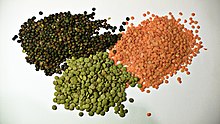Indian cuisine consists of a wide variety of regional and traditional cuisines native to the Indian subcontinent. Given the range of diversity in soil type, climate, culture, ethnic groups, and occupations, these cuisines vary substantially from each other and use locally available spices, herbs, vegetables, and fruits. Indian food is also heavily influenced by religion, in particular Hindu, cultural choices and traditions.[1] The cuisine is also influenced by centuries of Islamic rule, particularly the Mughal rule. Samosas and pilafs can be regarded as examples.[2]
Historical events such as foreign invasions, trade relations, and colonialism have played a role in introducing certain foods to this country. For instance, potato, a staple of the diet in some regions of India, was brought to India by the Portuguese, who also introduced chillies and breadfruit.[3] Indian cuisine has shaped the history of international relations; the spice trade between India and Europe was the primary catalyst for Europe's Age of Discovery.[4] Spices were bought from India and traded around Europe and Asia. Indian cuisine has influenced other cuisines across the world, especially those from Europe, the Middle East, North Africa, sub-Saharan Africa, Southeast Asia, the British Isles, Fiji, and the Caribbean
History
Indian cuisine reflects an 8,000-year history of various groups and cultures interacting with the Indian subcontinent, leading to diversity of flavours and regional cuisines found in modern-day India. Later, trade with British and Portuguese influence added to the already diverse Indian cuisine.[7][8]
Antiquity
Early diet in India mainly consisted of legumes, vegetables, fruits, grains, dairy products, and honey.[citation needed] Staple foods eaten today include a variety of lentils (dal), whole-wheat flour (aṭṭa), rice, and pearl millet (bājra), which has been cultivated in the Indian subcontinent since 6200 BCE.[8] Over time, segments of the population embraced vegetarianism during Śramaṇa movement[9][10] while an equitable climate permitted a variety of fruits, vegetables, and grains to be grown throughout the year. A food classification system that categorised any item as saatvic, raajsic, or taamsic developed in Yoga tradition.[11][12] The Bhagavad Gita proscribes certain dietary practices (chapter 17, verses 8–10).[13] Consumption of beef is taboo, due to cows being considered sacred in Hinduism.[14] Beef is generally not eaten by Hindus in India except for Kerala, parts of southern Tamil Nadu and the north east.[15]
Middle Ages to the 16th centuries
During the Middle Ages, several Indian dynasties were predominant, including the Gupta dynasty. Travel to India during this time introduced new cooking methods and products to the region, including tea. India was later invaded by tribes from Central Asian cultures, which led to the emergence of Mughlai cuisine, a mix of Indian and Central Asian cuisine. Hallmarks include seasonings such as saffron.[16]
Ingredients
Staple foods of Indian cuisine include pearl millet (bājra), rice, whole-wheat flour (aṭṭa), and a variety of lentils, such as masoor (most often red lentils), tuer (pigeon peas), urad (black gram), and moong (mung beans). Lentils may be used whole, dehusked—for example, dhuli moong or dhuli urad—or split. Split lentils, or dal, are used extensively.[17] Some pulses, such as channa or cholae (chickpeas), rajma (kidney beans), and lobiya(black-eyed peas) are very common, especially in the northern regions. Channa and moong are also processed into flour (besan).
Many Indian dishes are cooked in vegetable oil, but peanut oil is popular in northern and western India, mustard oil in eastern India,[16] and coconut oil along the western coast, especially in Kerala and parts of southern Tamil Nadu.[18] Gingelly (sesame) oil is common in the south since it imparts a fragrant, nutty aroma.[19] In recent decades, sunflower, safflower, cottonseed, and soybean oils have become popular across India.[20] Hydrogenatedvegetable oil, known as Vanaspati ghee, is another popular cooking medium.[21] Butter-based ghee, or deshi ghee, is used frequently, though less than in the past.[citation needed] Many types of meat are used for Indian cooking, but chicken and mutton tend to be the most commonly consumed meats. Fish and beef consumption are prevalent in some parts of India, but they are not widely consumed except for coastal areas, as well as the north east.[citation needed]
The most important and frequently used spices and flavourings in Indian cuisine are whole or powdered chilli pepper (mirch, introduced by the Portuguese from Mexico in the 16th century), black mustard seed (sarso), cardamom (elaichi), cumin (jeera), turmeric (haldi), asafoetida(hing), ginger (adrak), coriander (dhania), and garlic (lasoon).[22] One popular spice mix is garam masala, a powder that typically includes seven dried spices in a particular ratio, including black cardamom, cinnamon (dalchini), clove (laung), cumin (jeera), black peppercorns, coriander seeds and anise star.[23] Each culinary region has a distinctive garam masala blend—individual chefs may also have their own. Goda masala is a comparable, though sweet, spice mix popular in Maharashtra. Some leaves commonly used for flavouring include bay leaves (tejpat), coriander leaves, fenugreek leaves, and mint leaves. The use of curry leaves and roots for flavouring is typical of Gujarati[24]and South Indian cuisine.[25] Sweet dishes are often seasoned with cardamom, saffron, nutmeg, and rose petal essences.








No comments:
Post a Comment